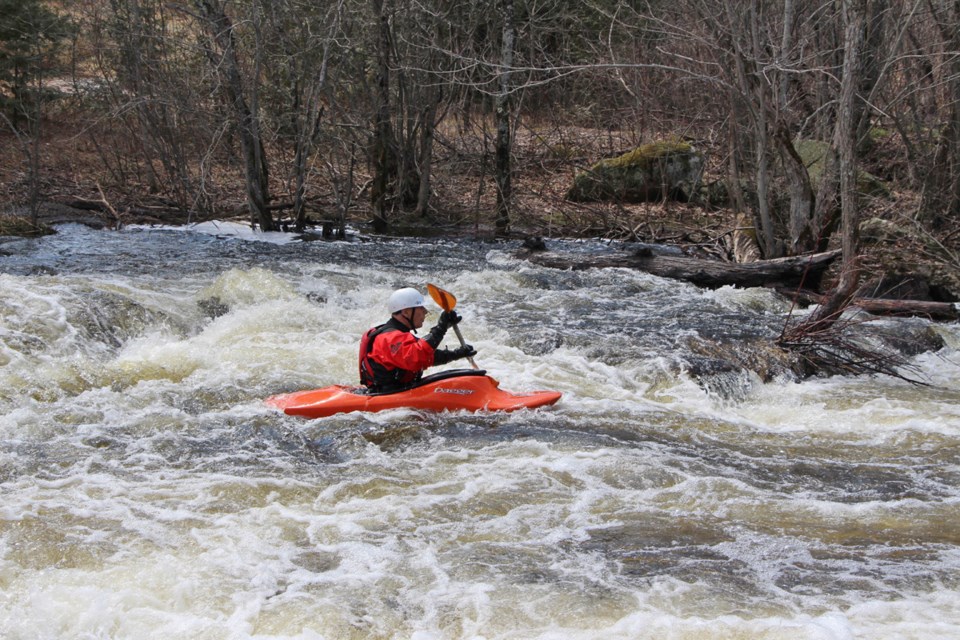While many of us have been anxiously waiting for warmer weather so we can get back to our favourite activities on the water, there’s one group of outdoor enthusiasts who don’t wait.
They are the whitewater paddlers who are extremely enthusiastic about getting back into their kayaks and canoes each spring. As soon as the ice disappears, they can be found manoeuvering their way down rushing waterways.
I caught up with some of these adventurers earlier this month on the Head River, just outside of Sebright, to find out what the attraction is to what seems like such a challenging activity.
Two regulars of the spring paddling community are Tony Reid, a semi-retired family physician, and Don Munro, a retired chiropractor – both of Orillia.
It was Reid’s first paddle of the season on what turned out to be a fairly warm, sunny day. Despite the pleasant weather, the paddlers methodically went through the preparation steps necessary to help ensure a safe run.
“The water is extremely cold, so the goal is to make it through the rapids without tipping and swimming,” explained Reid. “Even with a good drysuit on, if you end up rolling, your face and head get really cold.”
After pulling on their waterproof drysuits with foot booties and tight gaskets at the neck, wrists and waist, the paddlers put on their gloves, helmets and PFDs, and were ready and excited to shove off the riverbank into the wild water.
“Tony’s braver and more confident than I am,” admitted Munro. “Plus, in his kayak, he has a skirt, (that goes around the paddler’s waist and stretches around the boat opening) which means he can do crazy stuff I can’t do in my open boat.”
Munro’s open boat is a canoe with float bags installed. He’s not “skirted in” and uses a paddle with one blade, while the kayak paddle has two blades to manoeuvre through the turbulent water.
Now in their 70s, both Reid and Munro started whitewater paddling over two decades ago when they signed up for instructional courses with their kids.
“I wanted to learn whitewater paddling because my goal was to paddle the Nahanni River,” said Munro.
Although he didn’t end up making that trip to the wilderness river in Northwest Territories, Munro was hooked and continued to paddle many other rivers over the years.
“There’s nothing like the satisfaction of picking a line down a rapid and nailing it,” said Reid. “It’s challenging mentally and physically, and you’re outdoors on beautiful rivers. It’s just lots of fun and you meet some great people. It’s a small, but very supportive group.”
The spring flow of the Head River had, in fact, attracted some others within the group of whitewater enthusiasts.
Maureen Bretz of Horseshoe Valley, along with fellow paddlers Gail and Brian Shields of Cannington, and Al Sutton of Greenbank also met at the put-in to enjoy an early spring run on the river.
Also longtime paddlers, they too are not ready to give up the adrenaline-producing sport. They began paddling as teenagers and spent years exploring many of Canada’s most wild rivers.
Bretz and Gail Shields become champion competitive paddlers and first met when they worked together as guides with Black Feather Wilderness Adventures.
“It’s something we’ve picked up in our youth and just can’t let go of,” explained Brian Shields.
Being outside and on the river with friends is what keeps the paddlers motivated to keep making the trek to moving water, wherever it is.
“I love being on the river,” said Sutton. “There’s always something new to try.”
“Travelling rivers really enriches the paddling experience,” added Shields. One of the aims of whitewater paddling is to get totally comfortable with moving water so you can carry that into a multi-week trip on a bigger river. That’s probably the holy grail. You don’t want to be in fear the whole time – that’s no fun.”
The group readily admits that it can be a dangerous sport and stressed the importance of getting good instruction before tackling whitewater.
“I recommend taking a course or two to learn the basics,” said Reid. There are programs at places like the Madawaska Kanu Centre and Algonquin Outfitters in Minden near the Gull River.”
Reid explained that being a successful paddler is not so much about strength, but about your ability to understand the water flow in order to use its power and not fight against it.
“It’s all about your knowledge and skill at reading the water,” agreed Bretz. “And paddling with a group is always good and knowing your limits is essential.”
For this small group of very experienced paddlers, the day’s outing was a success. They were able to run six or seven “features,” (rapids) without swimming, had a chance to surf some waves, stayed warm and dry, and even enjoyed a traditional stop at Quaker Oaks for some delicious fruit tarts.
